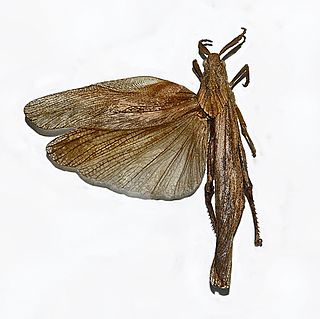
The subfamily Catantopinae is a group of insects classified under family Acrididae. Genera such as Macrotona may sometimes called "spur-throated grasshoppers", but that name is also used for grasshoppers from other subfamilies, including the genus Melanoplus from the Melanoplinae. Indeed, the delimitation of these two subfamilies needs restudy: the Podismini for example are sometimes placed here, sometimes in the Melanoplinae.

Bandwings, or band-winged grasshoppers, are the subfamily Oedipodinae of grasshoppers classified under the family Acrididae. They have a worldwide distribution and were originally elevated to full family status as the Oedipodidae. Many species primarily inhabit xeric weedy fields, and some are considered to be important locusts:

The grasshopper subfamily Acridinae, sometimes called silent slant-faced grasshoppers, belong of the large family Acrididae in the Orthoptera: Caelifera.

Conocephalus is a genus of bush-crickets, known as coneheads. It was described by Carl Peter Thunberg in 1815.

Tetrigidae is an ancient family in the order Orthoptera, which also includes similar families such as crickets, grasshoppers, and their allies. Species within the Tetrigidae are variously called groundhoppers, pygmy grasshoppers, pygmy devils or "grouse locusts".

Gomphocerinae, sometimes called "slant-faced grasshoppers", are a subfamily of grasshoppers found on every continent but Antarctica and Australia.

Pyrgomorphidae is a family of grasshoppers in the order Orthoptera; it is the only family in the superfamily Pyrgomorphoidea, with a pan-tropical distribution. Their name is probably derived from pyrgos meaning "tower": a reference to the form (morph) of the head in the type genus Pyrgomorpha and other genera.

Phymateus is a genus of grasshoppers of the family Pyrgomorphidae.

Acrotylus is a genus of grasshopper in the family Oedipodinae and the type genus of the tribe Acrotylini.

The Copiphorini are a tribe of bush crickets or katydids in the family Tettigoniidae. Previously considered a subfamily, they are now placed in the subfamily Conocephalinae. Like some other members of Conocephalinae, they are known as coneheads, grasshopper-like insects with an extended, cone-shaped projection on their heads that juts forward in front of the base of the antennae.

Atractomorpha crenulata, commonly known as the tobacco grasshopper, is a species of grasshopper in the subfamily Pyrgomorphinae, found in Asia.

Phymateus aegrotus, sometimes called the blue bush locust or East African bush locust, is a pest species of grasshopper in the family Pyrgomorphidae. Unlike "locusts" the adults are not known to change their morphology on crowding, but at the hopper stage, marching behaviour of small bands may occur.

Xiphoceriana atrox is a species of grasshoppers belonging to the family Pamphagidae.

Pyrgomorpha is the type genus of grasshoppers in the family Pyrgomorphidae and the tribe Pyrgomorphini. Species are found in Southern Europe, Africa and the middle East, through to India and Mongolia.

The Pyrgomorphinae are a sub-family of grasshoppers in the family Pyrgomorphidae. Species are found in, especially the warmer parts of: Central and South America, southern Europe, Africa, Asia, Australia and Pacific Islands. The type genus is Pyrgomorpha and names dates from "Pyrgomorphiden" by Brunner von Wattenwyl, 1874. The first use of Pyrgomorphinae was by Krauss in 1890.

The Orthacridinae are a sub-family of grasshoppers in the family Pyrgomorphidae. Species are found in: Central America, Africa, Asia, Australia and certain Pacific Islands. The type genus is Orthacris and the taxon proposed by Bolívar in 1905.

Cladonotinae is a subfamily of groundhoppers containing more than 70 genera and 260 described species. These insects are found in tropical areas world-wide.

Tagasta is a genus of grasshoppers in the family Pyrgomorphidae, subfamily Pyrgomorphinae and tribe Tagastini. Species can be found around the Himalayan mountains, southern China, Indo-China and Malesia. It was described in 1905.

Phymateus karschi is a locust in the family Pyrgomorphidae.

Neorthacris is a genus of wingless grasshoppers in the Pyrgomorphidae. Species in the genus are found in South Asia, mainly in subcontinental India.



















